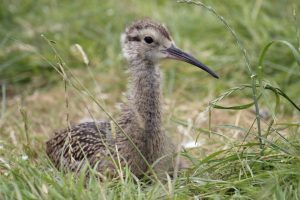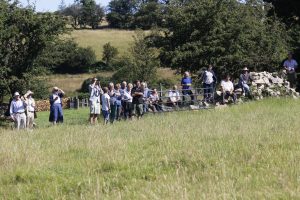Blog by Amber Bicheno, Project Assistant
 On Monday the 29th July, our 33 headstarted curlew were finally released into the wild. The day was many months in the making and changed frequently due to numerous factors out of our control. Originally, we hoped for 2, maybe even 3, releases of smaller batches of birds, as they were ready. In the end the release dates were pushed back, with some birds not looking quite ready, and after the realisation that none of the surrounding fields had been cut by mid-July, one big release became the best solution.
On Monday the 29th July, our 33 headstarted curlew were finally released into the wild. The day was many months in the making and changed frequently due to numerous factors out of our control. Originally, we hoped for 2, maybe even 3, releases of smaller batches of birds, as they were ready. In the end the release dates were pushed back, with some birds not looking quite ready, and after the realisation that none of the surrounding fields had been cut by mid-July, one big release became the best solution.
Getting the birds to this point has been a long and testing journey, with late nights, wet weather, and some odd curlew behaviour among some of the stresses. When in the incubation stage, there were some eggs that just wouldn’t behave, and which were losing too much or too little weight. Some of our eldest birds seemed determined to sabotage themselves by ingesting pieces of grass, which they pulled up from the root. One curlew had grass removed from its throat on three separate occasions, to really test our patience. Protective behaviours and squabbles broke out over sticks and stones, literally in some cases.
Despite all of these challenges, we were extremely pleased with the final figure of 33 chicks that were  released, an increase from the 21 in 2018. The physical release from the pens was the culmination of much overthinking by Rosie (our WWT headstarter) and me, to figure out the logistics of deconstructing ‘Fort Curlew’. The two pens had been painstakingly put together to make the risk of predation and injury to the chicks as low as possible. It included 6-foot skirted outer fence, stapled and pinned in place, a 4-strand electric fence, with added high wire just in case anything made to jump over, and the pen itself was lined at the base with chicken wire and a low mustelid fence. All of this we now had to get through in order to open the side panels and release our precious curlew.
released, an increase from the 21 in 2018. The physical release from the pens was the culmination of much overthinking by Rosie (our WWT headstarter) and me, to figure out the logistics of deconstructing ‘Fort Curlew’. The two pens had been painstakingly put together to make the risk of predation and injury to the chicks as low as possible. It included 6-foot skirted outer fence, stapled and pinned in place, a 4-strand electric fence, with added high wire just in case anything made to jump over, and the pen itself was lined at the base with chicken wire and a low mustelid fence. All of this we now had to get through in order to open the side panels and release our precious curlew.
 All available bodies were given roles and pieces of fencing to focus on in the hours leading up to the release. Rosie and I arrived bright and early at 7am, to give the birds some food and water before starting to remove the mustelid fence from the panels to be opened. At 8am reinforcements arrived and set to work on the electric and 6ft fencing. Care had to be taken at this point, as the birds became much flightier with so many more people around. We tried to limit disturbance as much as possible, keeping an eye on the chicks as we worked away. Eventually we reached the point where only a few cable ties lay between the curlew and freedom. Feeling more confident in our readiness, the team went to enjoy a bacon butty and to socialise with those that had been invited to watch.
All available bodies were given roles and pieces of fencing to focus on in the hours leading up to the release. Rosie and I arrived bright and early at 7am, to give the birds some food and water before starting to remove the mustelid fence from the panels to be opened. At 8am reinforcements arrived and set to work on the electric and 6ft fencing. Care had to be taken at this point, as the birds became much flightier with so many more people around. We tried to limit disturbance as much as possible, keeping an eye on the chicks as we worked away. Eventually we reached the point where only a few cable ties lay between the curlew and freedom. Feeling more confident in our readiness, the team went to enjoy a bacon butty and to socialise with those that had been invited to watch.
At 10am the time had come to say goodbye. Visitors lined up along the bottom field edge, in an effort to encourage the young curlew to head uphill, towards the plentiful food of the species rich grassland  and whimberries on the heathland. With 4 people on each pen, the panels were opened and pinned temporarily in place, before everyone retreated behind. As much as I would like to tell you that they all flew out with dramatic flair to ‘oohs’ and ‘ahhs’ from the onlookers, in reality they took their time making short walks to the new gap in the fence, surveying this very large new world, before venturing back into the pen for a snack. It took a few of the braver individuals to take those first few steps out before the rest eventually followed. For the most part they simply walked out into the surrounding long grass and started to forage naturally. Excitingly some did take flight, flying high above the crowd making their long bubbling calls before landing in a field nearby. Others made shorter flights, testing out the new-found space, and looking a little unsteady when trying to work out how to land again. From our perspective this was perfect, they left the pens steadily, quietly, safely and relatively quickly by walking out before testing their wings.
and whimberries on the heathland. With 4 people on each pen, the panels were opened and pinned temporarily in place, before everyone retreated behind. As much as I would like to tell you that they all flew out with dramatic flair to ‘oohs’ and ‘ahhs’ from the onlookers, in reality they took their time making short walks to the new gap in the fence, surveying this very large new world, before venturing back into the pen for a snack. It took a few of the braver individuals to take those first few steps out before the rest eventually followed. For the most part they simply walked out into the surrounding long grass and started to forage naturally. Excitingly some did take flight, flying high above the crowd making their long bubbling calls before landing in a field nearby. Others made shorter flights, testing out the new-found space, and looking a little unsteady when trying to work out how to land again. From our perspective this was perfect, they left the pens steadily, quietly, safely and relatively quickly by walking out before testing their wings.
Once all chicks had left the pens, and made their way further into the field, we leapt into action and shut the pens back up temporarily. We removed some food and water bowls to put outside to ensure it was not too much of a shock, and once all was secured retreated for a well-earned pub lunch. Once well fed and watered, and saying our farewells to the WWT colleagues who had joined us for the day, Rosie (WWT), JP, Tim and I (Curlew Country) went back to start on the mammoth task of dismantling the rest of the pen. Some of the curlew were still hanging around close by, so before doing any major work we walked them to the top of the field.
 After such an eventful start to the week, I sit writing this at my desk (between bouts of staple removal work) on Friday wondering what the future will hold for those young curlew. It has been such a pleasure to work with the aviculturists from WWT and Chester Zoo this year and knowing that we have given these birds the best start that we can. Now we must wait for sightings, and I will start work on report writing, fund raising, and trawling through hundreds of videos and photos that have been building up through the season, amongst a myriad of other jobs which have been put on hold. With one year left on the licence, I hope that next year we will be able to headstart once again, and know that if we do, we can only improve on the fantastic work of 2019.
After such an eventful start to the week, I sit writing this at my desk (between bouts of staple removal work) on Friday wondering what the future will hold for those young curlew. It has been such a pleasure to work with the aviculturists from WWT and Chester Zoo this year and knowing that we have given these birds the best start that we can. Now we must wait for sightings, and I will start work on report writing, fund raising, and trawling through hundreds of videos and photos that have been building up through the season, amongst a myriad of other jobs which have been put on hold. With one year left on the licence, I hope that next year we will be able to headstart once again, and know that if we do, we can only improve on the fantastic work of 2019.
